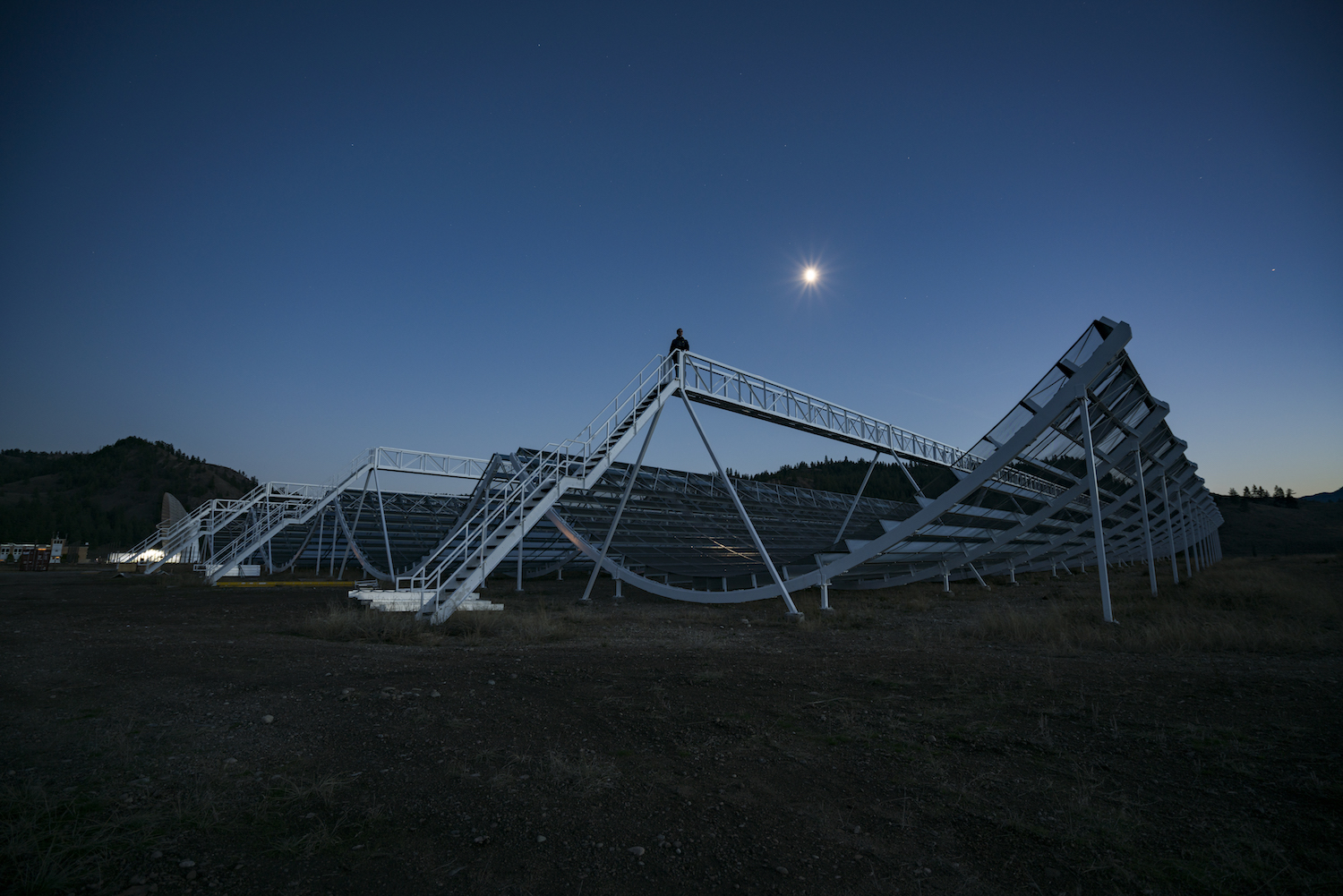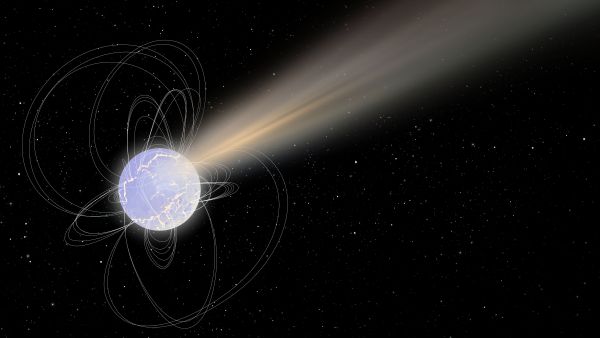Huge new catalog of ultrabright 'fast radio bursts' may shed light on the structure of the universe
The CHIME telescope in Canada spotted 535 new fast radio bursts during its first year of operation.

If human eyes could see radio waves, the night sky would periodically light up with flashes thanks to fast radio bursts (FRBs). It would, that is, if we looked quick: These pulses last less than a blink of an eye and then vanish without a trace.
FRBs are incredibly powerful, unleashing in just a thousandth of a second as much energy as the sun can generate in an entire year, according to NASA. What's more, they are relatively new to science, with the first one detected in 2007. They are elusive, and scientists have typically had to be very lucky to observe just one. But a groundbreaking Canadian telescope is successfully spotting FRBs at a much faster pace than before, nearly quadrupling the number of FRB sightings on its own.
This new catalog of FRBs, which was described on June 9 during a presentation at the 238th meeting of the American Astronomical Society (AAS), is allowing scientists to ask big-picture questions about the structure of the universe.
Related: Scientists paint best yet portrait of closest known fast radio burst

These short yet mighty pulses were once like single pieces of a massive jigsaw puzzle. The Canadian Hydrogen Intensity Mapping Experiment (CHIME), however, has scooped up enough new pieces that researchers can see which parts are like, which differ and how they fit together to reveal a bigger picture about the cosmos. And one major characteristic that allows FRBs to potentially answer grand-scale cosmic questions is something called dispersion.
"One of the truly special things about fast radio bursts is this property called dispersion. As the burst signal propagates through space, it gets distorted by the very diffuse plasma that lives in the cosmos," Kiyoshi Masui, a physicist at the Massachusetts Institute of Technology's (MIT) Kavli Institute for Astrophysics and Space Research, said during the AAS presentation.
"We can measure this distortion precisely, so for every one of these bursts, we know exactly how much matter it passed through," Masui said. "This carries a record within it of the structure of the universe that it has traveled through to get from the source to us. Because of this, we think that they are going to be the ultimate tool for studying the universe. With enough of them, we want to use them to map out where all the stuff is in the universe, what the structure of the universe is and how it's distributed on very large scales."
Get the Space.com Newsletter
Breaking space news, the latest updates on rocket launches, skywatching events and more!
During CHIME's first year of operation (2018-2019), the telescope recorded 535 new fast radio bursts. (The FRB catalog is publicly available to view here.) Masui and other team members measured the dispersion and location of each of these FRBs. They found the bursts were evenly distributed in space, "seeming to arise from any and all parts of the sky," according to an MIT statement detailing the new work.
Astronomers currently think that objects like neutron stars — especially a type known as a magnetar — are the sources of FRBs. The dispersions from FRBs with sources determined to be located closer to Earth than others are particularly interesting to scientists, because additional Earthly instruments with limited capabilities may be able to offer a new data angle on these sources as the instruments conduct their own observations.
Related: Hubble Space Telescope traces 5 mysterious 'fast radio bursts' to distant spiral galaxies
Masui and his colleagues found that most bursts, however, originated from far-off sources within distant galaxies. These ultrabright bursts journeyed toward Earth but not without first encountering interstellar gas and plasma.
"Having a large sample of FRBs unlocks countless possibilities. As one example, we are now in the era of using FRBs as cosmological probes," Alex Josephy, a physics Ph.D. student at McGill University in Canada, shared in a McGill statement about the new work. "We can begin examining large-scale structures — clusters of thousands of galaxies. We can help map the distribution of cosmic dark matter and study the evolution of matter throughout our universe's history."
Imagine a slow zooming-out perspective that starts with Earth, then recedes to show the entire solar system; then the Milky Way; our local galactic cluster; the Virgo supercluster, and so on until you reach the macro-universe. New tools like CHIME might support the next major cosmological breakthrough, piecing the universe puzzle together one ultra-bright flash at a time.
Follow Doris Elin Urrutia on Twitter @salazar_elin. Follow us on Twitter @Spacedotcom and on Facebook.
Join our Space Forums to keep talking space on the latest missions, night sky and more! And if you have a news tip, correction or comment, let us know at: community@space.com.

Doris is a science journalist and Space.com contributor. She received a B.A. in Sociology and Communications at Fordham University in New York City. Her first work was published in collaboration with London Mining Network, where her love of science writing was born. Her passion for astronomy started as a kid when she helped her sister build a model solar system in the Bronx. She got her first shot at astronomy writing as a Space.com editorial intern and continues to write about all things cosmic for the website. Doris has also written about microscopic plant life for Scientific American’s website and about whale calls for their print magazine. She has also written about ancient humans for Inverse, with stories ranging from how to recreate Pompeii’s cuisine to how to map the Polynesian expansion through genomics. She currently shares her home with two rabbits. Follow her on twitter at @salazar_elin.









